#get湯
Explore tagged Tumblr posts
Text
酸辣湯 (sour and spicy soup) my beloved.... ough so good when it's freezing outside!!
#i just woke up from my post work nap and discovered my mom made some 酸辣湯 and it's soooo good wahh#warms you up from the inside!#i will share if anyone wants some hehe#also i will get to the asks in my inbox soon! gotta think about responses hehe but i was delighted to see a notif that you sent an ask ily!#misc: zebra speaks
24 notes
·
View notes
Text

"When we get back, do you want to take a bath together?"

"You can get in the bath with just hot water"
#meoto de safari#ruka (mdsafari)#rei (mangaka)#safari spouses#geo (mdsafari)#georuka#it's not much i know but that lil roll of fat means so much to me lol#it's so much more than most get#i love her#i'm awkward in translating geo's line... i'm not 100% confident bc of the handwritten katakana but i think that's 'yu to' and by context is#���と if i have it right...#he's basically saying she doesn't need him just to take a bath#all she needs is hot water#i don't think he even realizes he's being snarky XD#he has one brain cell and it's dedicated entirely to gun
1 note
·
View note
Note
so excited to see this blog!! Maybe a soup dragon?

#3 -湯王 (soup king)- This silly guy is always happy to make soup for you! He might get too excited and burn it a little...don't be too mad... 🍲🥄💕
#ask and you shall receive :3#art#chinese artist#art challenge#artists on tumblr#dragon#dragon a day#dragon art#dragon oc#dragons#illustration#year of the dragon#daily dragon drawing#daily dragon#chinese dragon#zodiac#original art#daily drawing
2K notes
·
View notes
Text
Upcoming Card!!
GUYS I FORGOT TO DO THIS THIS MORNING ANYWAY HERE'S ONSEN TAIGA


My man does not remember ever having seen milk before. Why is this liquid cow white. Also we were this 🤏🏾 close to exposed Taiga thigh! And DOUBLE FEET FOR FREE!!!!! And Ritsu havin a sippy!!!
Character Card: Morning Invitation(「気怠い朝光の誘惑」 "Temptation of the Lazy Morning Light") Skill: Selfish Sleeper(「手前勝手な寛ぎ」 "Selfish Relaxation") Fully Awakened Skill: Morning Voice(「朝一の声掛け」 "Greeting First Thing In The Morning") Warding Card: Fresh From The Bath(「湯上りの定番」 "Post-Bath Staple")
No new cosmic bonds again! And you know what I'm going to say here!
Gacha is gambling and banners rerun! Don't spend anything you can't afford to even if you don't get the unit you want!! Gambling is a real problem and you should seek help if you find you're spending out of control!
My Japanese is not the best so take my translations with a grain of salt!
Go back to bed. . .the boss is waiting. . .how often do you get to sleep in, huh?
#taiga hoshibami#tokyo debunker#tokyo debunker spoilers#datamining cw#danie yells at tokyo debunker#i should set myself an alarm so i remember to check these when a banner is ending lol#ritsu shinjo
153 notes
·
View notes
Text




Sean bienvenidos, amantes del mundo japonés, de su historia, su cultura, entre otros temas. Una vez dicho esto, pónganse cómodos que comenzamos con la historia de la yukata. - Antes que nada, no tenemos que hacer la pregunta: ¿Qué es la yukata? ¿Y cuándo surgió? Esta prenda tradicional japonesa surgió durante el periodo Heian (794-1192 d.C.). Fue usada por la aristocracia y era una vestimenta asociada a los baños públicos, llamados onsen; en japonés sería 温泉 y en hiragana おんせん, que se traducirían como aguas termales ♨️️️️. Dicha prenda era utilizada, una vez que salían del baño, para evitar quemarse con el vapor. La etimología de yukata sería yukatabira, ya que era la prenda que se utilizaba para bañarse durante el periodo Heian. - Esta prenda estaba hecha de lino porque fue un material principal e importante. Durante dicho período, en periodos más tardíos, se empezaron a utilizar después del baño o como pijama y se empezaron a hacer de algodón, ya que en aquella época la regla era teñir el algodón de blanco. - Espero que os haya gustado y nos vemos en próximas publicaciones. Hasta la próxima. -
日本の世界、その歴史、文化などを愛する皆様、ようこそ。それでは、心地よく浴衣の歴史についてお話していきましょう。
まず、「浴衣とは何か?」という質問をする必要はありません。そしてそれはいつ現れたのでしょうか?この日本の伝統的な衣服は平安時代(西暦794~1192年)に誕生しました。それは貴族によって使用され、温泉と呼ばれる公衆浴場に関連した衣服でした。日本語では「温泉」、ひらがなでは「おんせん」となり、温泉♨️️️️と訳されます。この衣服は、湯船から上がった後に湯気で火傷するのを避けるために使われました。浴衣の語源は、平安時代に入浴時に着用されていた衣服である「ゆかたびら」です。
この衣服はリネンで作られました。リネンは主要かつ重要な素材だったからです。この時期、後の時代には、入浴後やパジャマとして使われるようになり、当時は綿を白く染めるのが規則だったため、綿で作られるようになりました。
楽しんでいただけたら幸いです。今後の投稿でもお会いしましょう。また次回お会いしましょう。
-
Welcome, lovers of the Japanese world, its history, its culture, among other topics. That being said, make yourselves comfortable, as we begin with the history of the yukata.
-
First of all, we don't need to ask the question: What is the yukata? And when did it originate? This traditional Japanese garment emerged during the Heian period (794-1192 AD). It was worn by the aristocracy and was associated with public baths, called onsen; in Japanese it would be 温泉 and in hiragana おんせん, which translates as hot springs ♨️️️️. This garment was worn after leaving the bath to avoid getting burned by the steam. The etymology of yukata is yukatabira, as it was the garment used for bathing during the Heian period. - This garment was made of linen because it was a primary and important material. During this period, in later periods, they began to be used after bathing or as pajamas, and they were also made of cotton, since at that time the rule was to dye cotton white.
-
I hope you liked it, and I'll see you in future posts. See you next time.
#日本#japan#history#歴史#ユネスコ#unesco#archaeology#考古学#art#geography#photo#japan photos#art on tumblr#artists on tumblr#culture#yukata#浴衣
80 notes
·
View notes
Text
Some stuff I had while in Tainan:

牛肉湯 (Tainan-style beef soup). NTD$100. Fresh beef in a light broth with shredded ginger.

四神湯、碗粿、蝦仁肉圓 (left to right). NTD$40 each.
四神湯 (si4shen2tang1; four herbs soup) is traditionally a broth made of lotus seeds, chinese yam, gorgon fruit, and barley. I think this one might be just 薏仁 (pearl barley) and pig intestine though.
碗粿 (Hokkien: uánn-kué; lit. bowl cake) is a sticky rice cake. This one uses southern-style ingredients: shiitake mushrooms, egg yolk, pork, dried shrimp, topped with soy sauce paste.
肉圓 (Hokkien: bah-uân) is a sticky dumpling made of glutinous dough, filled with pork and other ingredients. This one was filled with shrimp and braised pork then steamed, and is a Tainan specialty.

百香果 (passion fruit). I only ever get the preserved stuff in Canada, so it was nice to have fresh passion fruit for once.

虱目魚丸湯 (milkfish ball soup). NTD$130/bowl. The one I ordered had all the fixings: 魚肚 fish belly, 魚皮 fish skin, 肉餃 pork dumplings, 粉蒸 fish covered in a rice flour paste and steamed, 脆丸 milkfish balls, 蝦丸 shrimp balls

糖葫蘆 (tanghulu). NTD$40. Fruit covered in a thin coating of hardened sugar. I got a grape tomato and preserved plum (蜜���) skewer, but vendors were selling strawberry and just tomato ones as well. I did see one vendor selling grape and mandarin orange ones, though.
42 notes
·
View notes
Text
youtube
Yu Yu Hakusho x Jalan CM
"I didn't see a hot spring for nothing!"
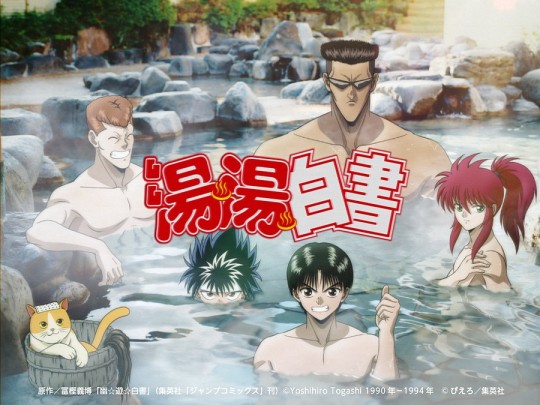
湯♨️湯♨️白書 (Yu Yu Hakusho) is a pun with the title! The kanji "湯"can also be read as "Yu" and it means "hot bath/spring", different from the kanji "Yuu" (幽, ghost) and "Yuu" (遊, play) of the original title 幽☆遊☆白書 (Yuu Yuu Hakusho). It seems Elder Toguro shapeshifted into that bucket where the cat is relaxing.
Jalan.net, a travel reservation site operated by Recruit, released a new web commercial with Yu Yu Hakusho. Many characters from "Yu Yu Hakusho" experience the limited time sale "Jalan Special Week", which is offering discounts and coupons for accommodations.
The content was exclusively drawn and recorded for this WebCM. The story, narrated by Nozomu Sasaki like a Next Episode Preview, depicts Yusuke Urameshi and his friends, exhausted from the fierce battles of the Dark Tournament, taking advantage of limited-time sales and enjoying luxurious inns and hot springs.
Yusuke is having fun with Puu...

...and taking Keiko out for dinner.
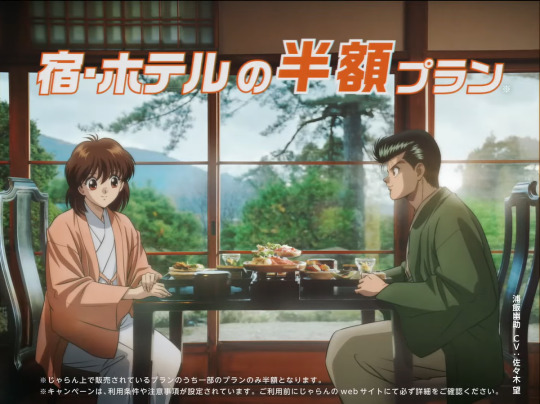
Daddy Youko is killing it!

It seems hot water changes Youko back into Shuuichi! And, we finally get to see some Kurama skin!

Hiei is also enjoying a good hot spring, boiling an Onsen Tamago with his black flames...

...and watching over Yukina.
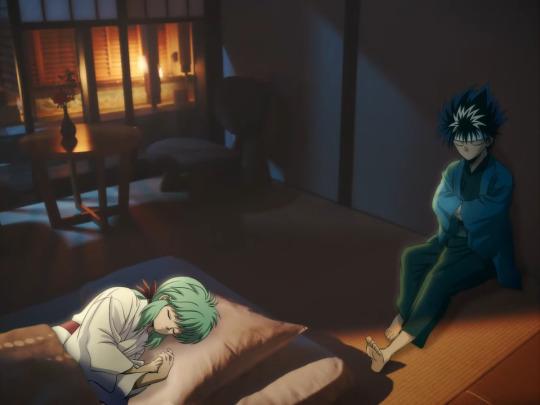
Kuwabara is too cute! I don't think this cat is Eikichi, maybe it belongs to the onsen.
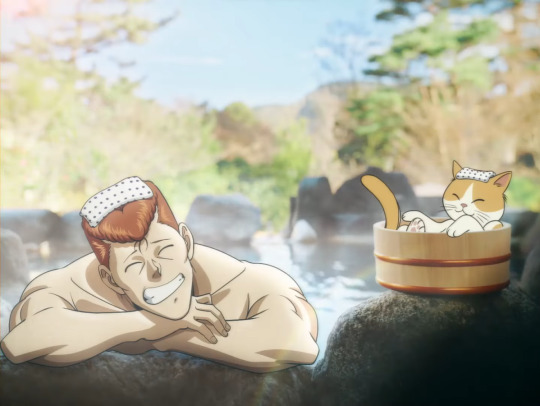
OMG, Elder Toguro is almost naked!!!

Additionally, to commemorate this collab, a campaign will be held on Jalan's official X account, where you can win special hand towels. The period is from January 31 until February 8, 2024. All you'll need to do is follow their account and repost the target campaign post.
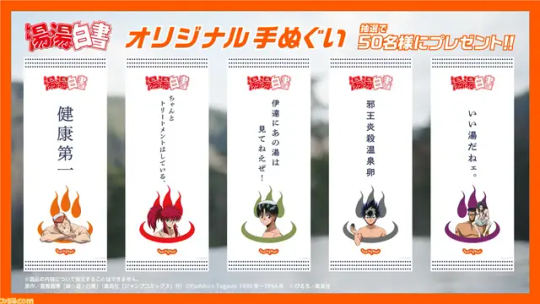
This art is so beautiful, we need a remake of the anime!

#幽遊白書×じゃらん#Yu Yu Hakusho x Jalan#Jalan Special Week#Yusuke Urameshi#Puu#kazuma kuwabara#hiei#kurama#Youko Kurama#Yukina#Toguro Brothers#Keiko Yukimura#Youtube#Nozomu Sasaki
210 notes
·
View notes
Text
Maomao no Hitorigoto Episode 37 “Modest” / 猫猫のひとりごと 第37話『つつましやか(Tsutsumashi-yaka)』
You can watch the video on YouTube, uploaded by the official Toho Animation account.
Please note that the English lines are just my translation.
小蘭「つって(伝手/Tsute)を作(つく)るぞ~♪」
Shaoran “Tsutte’o tsukuru-zooo♪”
Xiaolan “Let’s make some connections♪”
The reason that she says つって instead of つて is just to say rhythmically.
子翠「お――!くっし(櫛/Kushi)をもらうぞ~♪」
Shisui “Ooooo! Kusshi’o morau-zooo♪”
Shisui “Yeah! Let’s get a comb♪”
おー!: In Japan, just before a group challenge, such as a sports game or a stage performance, all the members gather and someone says “えい、えい(Ei, ei)” to inspire themselves, and then everyone will shout “おー!(Ooo!)”. “えい、えい、おー!” is a typical phrase, but in reality, each group will use a different shout. In this scene, the conversation flow is “Let’s do it!”, followed by “Yeah!” You can see that the two are fired up to take on the same challenge.
小蘭「お―!おー!」
Shaoran “Ooo! Ooo!”
Xiaolan “Yeah! Yeah!”
おー!: Same here as above
猫猫「フゥ…。魂胆(こんたん)がダダ漏(も)れだな…」
Maomao “Fuu… Kontan’ga dada-more-dana…”
Maomao “Phew… Your true intentions are all too obvious…”
魂胆(こんたん/Kontan): an ulterior motive, secret/true intention
ダダ漏れ(だだもれ/Dada-more) = ダダ(だだ/Dada): over-, excessive, extreme + 漏れる(もれる/Moreru): leak out, escape, shine through, seep from
子翠「あっ!猫猫~!」
Shisui “A! Maomaooo!”
Shisui “Ah! Maomao!”
小蘭「もーぅ、遅(おそ)いよ~!湯殿(ゆどの)に行(い)くよー!」
Shaoran “Mooo, osoi-yooo! Yudono’ni iku-yooo!”
Xiaolan “Come on, you’re late! Let’s go to the bathhouse!”
猫猫「ごめんごめん」
Maomao “Gomen gomen.”
Maomao “Yeah, sorry.”
ごめんごめん is more casual than ごめん. In Japanese, it’s sometimes impolite to repeat the words like ごめん(sorry) or はい(yes), so we don’t say ごめんごめん or はいはい to a higher-ranking person. It’s okay when speaking to friends or someone close.
子翠「あれ?赤羽様(セキウさま)は?」
Shisui “Are? Sekiu-sama’wa?”
Shisui “Huh? Where’s Lady Seki-u?”
猫猫「先(さき)に行(い)くって」(また引(ひ)っぺがされるのを恐(おそ)れたか…)
Maomao “Saki’ni ikutte.” (Mata hippega-sareruno’o osoreta-ka…)
Maomao “She said she would go first.” (I guess she’s afraid of having her clothes pulled off again…)
引っぺがす(rough) = 引きはがす(ひきはがす/Hiki-hagasu): pull off, remove, peel off, tear off
小蘭「そういえば、今日(きょう)も脱毛(だつもう)の予約(よやく)、いーっぱい入(はい)ってるよ!」
Shaoran “So-ieba, kyo’mo datsumo’no yoyaku, iiippai haitteru-yo!”
Xiaolan “By the way, there’re a ton of hair removal appointments booked today!”
猫猫「ここで、猫猫の豆知識(まめちしき)。糸脱毛(いとだつもう)は、近隣���(きんりんごく)で古来(こらい)より行(おこな)われていた脱毛方法(だつもうほうほう)。産毛(うぶげ)の除去(じょきょ)だけでなく、肌表面(はだひょうめん)の老廃物(ろうはいぶつ)や古(ふ��)い角質(かくしつ)などを、少(すく)ない負担(ふたん)で取(と)り除(のぞ)くこともできる」
Maomao “Koko’de, Maomao’no mame-chishiki. Ito-datsumo’wa, kinrin-goku’de korai’yori okonawa-rete-ita datsumo-hoho. Ubuge’no jokyo-dake’de-naku, hada-hyomen’no rohai-butsu-ya furui kakushitsu-nado’o, sukunai futan’de tori-nozoku-koto’mo dekiru.”
Maomao “Here’s Maomao’s bits of knowledge. Threading is a hair removal method that has been used since ancient times in neighboring countries. It’s not just for removing fuzz, it can also remove waste products and dead skin cells from the surface of the skin with minimal stress.”
子翠「猫猫って、薬(くすり)のことだけじゃなくて、美容(びよう)にも詳(くわ)しいんだね~!」
Shisui “Maomaotte, kusuri’no koto-dake-ja nakute, biyo’nimo kuwashiin-daneee!”
Shisui “Maomao, you know a lot not only about medicines, but about beauty care too!”
猫猫「花街(はなまち)にいたからね」
Maomao “Hana-machi’ni ita-kara-ne.”
Maomao “Because I was in the pleasure district.”
小蘭「もしかして!…つつましやかじゃない胸(むね)にする方法(ほうほう)、知(し)ってる!?」
Shaoran “Moshika-shite! …Tsutsumashi-yaka-ja-nai mune’ni suru hoho, shitteru!?”
Xiaolan “Perhaps, …do you know how to make breasts more than modest!?”
つつましやか(Tsutsumashi-yaka): (seems like) modest = つつましい(Tsutsumashii): modest + やか(yaka): like~, close to~ It’s not completely modest but close to modest.
猫猫「えっ?」(気(き)にしてたのか…)
Maomao “E?” (Ki’ni shiteta-noka…)
Maomao “Huh?” (So she’s worried about it…)
子翠「こんなの重(おも)たいだけだよ~!つつましやかな方(ほう)が身軽(みがる)で、虫(むし)も捕(つか)まえやすそうだし、うらやま…」
Shisui “Konna’no omotai-dake-dayooo! Tsutsumashi-yakana-ho’ga migaru’de, mushi’mo tsukamae-yasuso-dashi, urayama……”
Shisui “This is just heavy! The modest one is lighter and good to catch insects easily, so I envy―”
小蘭「む―――…」
Shaoran “Muuuuuuu…”
Xiaolan “Hmmmmm…”
子翠「はっ!!さっ、さ、早(はや)く行(い)こ~っ!伝手(つて)を作(つく)るぞ~♪」
Shisui “Ha!! Sa, sa, hayaku ikooo! Tsute’o tsukuru-zooo♪”
Shisui “Oh! Come on, let’s go quickly! Let’s make some connections♪”
小蘭「むむむむむむ…」
Shaoran “Mumumumumumu…”
Xiaolan “Hmmmmmmmmmmmmm…”
子翠「お――ぅ…」
Shisui “Oooooo…”
Shisui “Yeah…”
猫猫「ハァ…。次回(じかい)、『踊(おど)る幽霊(ゆうれい)』。今度(こんど)は金剛宮(こんごうきゅう)で、騒動(そうどう)が巻(ま)き起(お)こる…」
Maomao “Haa… Jikai, ‘Odoru Yurei’. Kondo’wa Kongo-Kyu’de, sodo’ga maki-okoru…”
Maomao “(Sigh) Next Episode, “The Dancing Ghost.” A commotion will break out at the Diamond Pavilion this time…”
#apothecary english#apothecary romaji#the apothecary diaries#apothecary diaries#learning japanese#japanese#薬屋のひとりごと#薬屋のひとりごと 英語#薬屋 英語 学習#japan
14 notes
·
View notes
Text

蓬[Yomogi] Artemisia indica
The grass grows to around 1.2 meters in height and blooms with modest flowers in autumn. It does not seem to care about the environment as long as it gets enough sunlight, and is commonly found in mountains, wastelands and so on. It is one of the so-called weeds.
On the other hand, it is used for a variety of purposes, such as moxa, tea, herbal wine, a medical plant, a wild vegetable, a dough for mochi sweets, etc. https://en.wikipedia.org/wiki/Kusa_mochi
Today, December 21, is 冬至[Tōji](Winter solstice) and there is a custom of taking a bath with 柚子[Yuzu](Citrus junos) called 柚子湯[Yuzu-yu]. Similarly, on 端午の節句[Tango no sekku](Boy’s Day celebration, on the fifth day of the fifth month of the lunar calendar, now May 5), people take a bath with 菖蒲[Shōbu](Acorus calamus) called 菖蒲湯. There are also other types of bathes, such as with the leaves of 菊[Kiku](Chrysanthemum) called 菊湯[Kiku-yu], with the leaves of 桃[Momo](Peach) calld 桃湯[Momo-yu], and in recent years, with the fruits of 蜜柑[Mikan](Mandarin orange) or 林檎[Ringo](Apple), etc. https://en.wikipedia.org/wiki/Yuzu_bath
And, there is also 蓬湯 with 蓬 in it. Although there are a variety of Japanese herbs, of those, I think 蓬 has the widest range of uses.
19 notes
·
View notes
Text
Fun Facts abt the residents according to Ikevamp Radio (ヴァンなま) Part 1
Found a playlist of Ikevamp Radio that occurred multiple years ago so I decided to collect my findings about the residents in a list. I haven't seen anyone translate it or talk abt it so I decided to do it for a bit of fun. Anyways, here are episodes 1-3!!
Some quick things to note before:
Vincent/Aramaki Yoshihiko (Makki) is the MC, Sebas/Morishima Shuta (Morishi) is a guest (but he’s in every episode he might as well be the 2nd MC). They also have other people as guests in some episodes (other ikevamp VAs or others related to the game itself)
Episodes 1 & 2 occur before Ikevamp’s release
most of my findings are from a segment from the livestream where the residents (mainly Vincent and Sebas) talk to each other & ask each other questions about the lives while they spend some bonding time in the thermae. The segment's called "I love yu" which is a pun on "I love you" and yu (湯) which means "hot water" or "bath"
There are also other segments where the VAs draw based on a designated theme & the viewers vote on the best art (van Gogh's drawing section), and another one where the VAs read the summary of the game in their in-character voices (but the VAs interrupt and make it funnier & less romantic) called "Ikemen Vampire, a guidance for you" (I won't talk abt these sections much tho)
ALSO!! This is not a translation of the whole livestream, just bits and pieces of it. I don't have the time and energy to do that
Episode 1: feat. Leonardo's VA Tsuda Kenjiro
youtube
Question: Which historical figure/genius do you respect the most?
Napoleon: Oda Nobunaga
Mozart: Johann Sebastian Bach
Leonardo: Michelangelo (which I thought was interesting since real-life Leo and Michelangelo had some beef w each other)
Morishima (Sebas’s VA): Newton (bc of the apple & theory of universal gravitation), Edison
Tsuda (Leonardo’s VA): van Gogh
Aramaki (Vincent’s VA): Liu Bei, Zhao Yun (I think that's who he was talking abt? I'm not familiar much w/Chinese figures' names in jp---they're read differently in Eng)
The other VAs joke that Aramaki’s similar to Napo in the sense that they both admire soldiers/military commanders
Question: Favorite part of a woman’s body? (This sounds so wrong in both jp & eng)
Napoleon: from the neck to the shoulder, he's prob talking abt the shoulders to the neckline or vice versa(首から肩まで)
Mozart: voice (so he can understand what his partner’s thinking & feeling)
Leonardo: thighs (bc it’s soft & he likes lap pillows)
Tsuda said Leo’s a bit of a pampered/attention-seeking child (甘えん坊), and not an ore-sama (which he thought Leo would be), an unexpectedly cute reason considering how reliable Leo looks
Vincent gets a bit sad when he’s bathing alone
Leo can sing a song that he’s only heard once (as expected of a genius)
Sebas can be seen hanging the sheets outside from Vincent’s room
Leo’s unsatisfied that there’s only men in the mansion (this was before MC stumbled to the mansion)
Vincent doesn’t want women in the mansion bc he wouldn’t know how to act in front of them
Sebas thinks Leo is an expert in handling women, Leo is confused when he became one
Leo’s weak against Vincent’s pleas/suggestions (honestly who isn’t??)
Sebas thinks it’s impossible for a woman to stumble upon the mansion (foreshadowing)
Leo thinks that fate will play a trick on them, his mumbling confuses Vincent and Sebas (more foreshadowing)
Episode 2: feat. Jun, singer of Ikevamp theme song "Rouge"
youtube
Jun is a repairman who fixes things around the mansion… HE'S ALIVE IN THAT ERA???? (Idk if its canon)
He also sings “Rouge” while he works which means the song exists in the 20th century (again idk how much of this is canon)
Jun also sells milk in the mansion, acting as a different person as the repairman, although Sebas & Vincent are suspicious of him (he literally just enters the bath to sell milk to Vincent and Sebas lol)
Vincent and Sebas talk about MC, she has arrived @ the mansion
Vincent worries abt her since she is surrounded by vampires in an unfamiliar environment, but to Sebas, it looks like MC enjoys her life and is headstrong (aka Vincent is just nice to others, nothing new)
Vincent believes that Sebas is cool and can do anything, to which Sebas indirectly disagrees (he coughs)
Sebas is weak to Vincent’s innocent eyes (just like Leo from the previous episode, again, who isn't?)
Sebas breaks the 4th wall talking abt a popular romance game where you can fall in love w/vampire-turned historical figures
This is literally the beginning of how Sebas goes ooc (becomes weirder) throughout the series (is it even ooc if it’s basically approved by official??)
Sebas says that Theo is overprotective of Vincent, Vincent comments that he’s supposed to be the older one
they also introduce my fav segment (Can you tell me... your name?) where they have listeners vote on quotes they want the VAs to say, and they will say the line w/the listener’s names so it sounds like the VAs are speaking to them. Vincent's & the guest (if there is one) will have legit cool lines (like “(y/n), Don’t let go of me” or “(y/n), you’re the only one in my eyes”) but Sebas always has one funny line as one of his options (ex. “Hey, do you wanna have a takoyaki party?” or “Do you want to fry one more sanma?”) and every single time the weird line gets voted and ITS FUNNY AS HECK
Also in the same segment the viewers will sometimes submit funny names for the VAs (especially Sebas) to say & it adds to the laughs
Ex. for Sebas’s “Hey, do you wanna have a takoyaki party?” some viewers gave names of Anpanman characters (a children’s anime in Japan) so Sebas will literally say things like “Jam-ojisan, hey, do you wanna have a takoyaki party?”
There was also one whose name was Tako (octopus in japanese) so Sebas would say “Tako, do you wanna have a takoyaki party?” so he’s asking the octopus to have a takoyaki party where the octopus will be eaten (the irony as well as the dark underlying meaning behind it is very funny)
Also the way the other people are laughing while Sebas’s VA is trying to keep his cool is so hilarious
It’s predetermined and agreed upon the Ikevamp staff that Sebas (or Morishi) is willing to do/say weird things for the audience
This whole segment is a whole ride in and out of itself
Episode 3: feat. Leonardo’s VA Tsuda Kenjiro once again
youtube
Sebas once again breaks the 4th wall by referencing episode 1 of the show
Sebas teaches Leo the basics of manzai (a type of japanese comedy)
Leo says “Vannama” (the name of ikevamp radio) and “tendon” (the food and a manzai phrase) in a weird accent further proving that he doesn’t understand Japanese (or maybe it's bc the two phrases are too specific idk)
Sebas tells Leo to ignore what he’s saying as he is saying metafictional expressions (メタ発言) basically how he is breaking the 4th wall, and Leo just accepts that as another one of Sebas’s quirks
Vincent comments that Leo’s very manly, Sebas further compliments him saying that Leo is a man amongst men
This episode has one of the funniest (imo) “Can you tell me… your name?” segments ever. Vincent and Leo’s VAs had amazing lines, but Sebas… oh gosh where do I even start. (ok Leo’s VA did say “Ushi (cow), wait for me by the bed,” and “Namamono (raw food), wait for me by the bed” & that was funny too but…)
One of the options for Sebas’s lines (and the one that was ultimately chosen to be said) was “Do you want to fry one more sanma (a type of seasonal fish eaten in fall)?” and the viewers got crazy with this one.
There were some legit names but most were for jokes, choosing names going along with the theme of fall foods and creatures (tuna, matsutake, karaage, grasshoppers, etc.)
There was “Akashiya, sanma mouipikki yaku?”(Akashiya, do you want to fry one more sanma?) which was the funniest one. Akashiya Sanma is a very famous Japanese comedian and it’s very genius of the viewer to connect the person with the food. I laughed straight for like 10 min when I first listened to this (I still laugh just remembering it. The double-entendre!!!)
Literally any episode with Tsuda is chaotic (this isn’t the last time where he shows up)
At the end of the episode, Vincent’s VA couldn’t stop laughing and messed up his lines multiple times (I don’t blame him everything is just so funny)
#this is such a fever dream#the VAs are just as chaotic/if not more#im so late#ikevamp#ikevamp vincent#ikevamp sebastian#ikevamp leonardo#ikevamp radio#ikemen vampire#rough translation#lukka talks
97 notes
·
View notes
Text
i picked on gaga's english subs last time but hey i think it redeemed itself?

赴湯蹈火 is another super common idiom
赴 (fu) = go to/attend
湯 (tang) = soup (hot liquid in general, hot being the key word here)
蹈 (dao) = step/tread
火 (huo) = fire
taken together it means willing to face any difficulties (nothing about actually getting "through" said difficulties though)

iqiyi gets the gist, but i do take issue with the "through"

viki's is probably most accurate in terms of general meaning, but i personally like the imagery of hot water and fire highlighting jin bao's earnestness
#meet you at the blossom#super random translation note that doesn't really make a whole lot of difference#but well i'm always interested to see how different subbers translate these proverbs#this one translates#this one rambles
22 notes
·
View notes
Note
Erhh were peter a good husband at least? I really enjoy your blog dude
A Happy Couple
Oh, yeah!! He was a great husband!! Just a shit “dad.”
⚠️CW!!: gross alpha-male-on-twitter style bullshit, gross purity shit, I basically took gross people on twitter and shoved it into this dude, abuse
Speaking of Couples!!
Some of the dynamics between Liu and his mom are based on my husband!!
He’s Chinese and the religion I describe here is the one that he follows. I actually named some of these people that I mention here after him and his family. That being said, this might have a mildly different tone and such because he’s like- (I’m using the name as an example)
Him: what the fuck are you doing, no! Last name first.
Me: but how do they know if I’m taking about her or her husband.
Him: put her first name afterwards!
Me: …
Him: also, you’re spelling that wrong
Me: HUH-
I Done Goofed
That being said…
I realised I’ve been spelling her name wrong this whole time omg! He pointed out I had been spelling her transliterated name wrong… so, the name of the Chinese one I had put in is also wrong… GODDAMNIT
湯申 [Tang Shen] > Maiden Name
韓沉 [Han Shen] > After Marrying Han Shang
Sorry for the long-ass intro 😮💨
Let’s get into this now lmao

Their Meeting
You can find how they met here! I’m just gonna summarise the main points
They met in China. Peter was there for work shit and well… Shen was just there.
This man barely understood Chinese but pretended to in order to fill the gaps.
This man literally missed entire stories about Shen and Liu. He figured she was talking about a friend… nah dude that’s her damn CHILD!!

Peter’s Gross View on Women
He wanted a virgin, untouched, pure, wife.
He figured, if he was gonna find that anywhere, it would be in East Asia
<*insert my Chinese husband gagging*>
He figured that, by default, she was a virgin. This was proven wrong as soon as she came to the states.
Liu wasn’t often with her when they met up for… obvious reasons-
Why would a 4 year old care about what grownups are saying?
He thought they should all be devoted catholics and that this was true all over the world.
In reality, She and her son followed a folk religion.

Their Religion Clashing
I mentioned some of it here
The main issue was food.
Birds, Shrimp, and Pork are a BIG no-no. Pork was ok but after the way they were domesticated, it isn’t anymore.
However, Catholicism says nothing is wrong with that!!
Of course, little Liu isn’t gonna allow that and even stops his mom from eating some of the stuff.
A lot of sugary things like rich cakes and chocolate are a no-go. So, when Peter brought her chocolates and such, she politely declined.
Peter was actually respectful towards his wife. But NOT his stepson

Holidays and Such
He was always sure to give her flowers on valentines.
He gave her special treatment on her birthday.
Treated her to dinner on Mother’s Day since she works so hard.
Kisses her before sleep every night.
Makes sure she’s taken care of, even if he’s not the one working.
He lets her sit back and relax once she gets home.
He’ll (sort of) take care of Jeff and beat Liu while she’s out
“In our faith, he would be cast into darkness after death” - My Husband

She was Oblivious
The only way this woman would have no clue her son was getting the shot beat out of him every other day was if her husband showed zero red flags.
He was always so kind to her.
He couldn’t have possibly done anything bad…


Dividers by sisterlucifergraphics and adornedwithlight
#creepypasta#creepypasta fandom#crp#crp fandom#creepypasta headcanon#crp headcanon#homicidal liu#jeff the killer#creepypasta jeff the killer#jeffery woods#jeff the killer creepypasta#jeff woods#creepypasta jeff#jeff creepypasta#liu woods creepypasta#homicidal liu creepypasta#creepypasta homicidal liu#creepypasta liu#liu creepypasta#homicidal liu headcanons#jeff the killer headcanons
12 notes
·
View notes
Text
Hiraeth TL
(i have been translating a LOT recently, pleaaase ask me if u want my google docs folder! most songs in fictions are done + some of my older TLs from other albums! enjoy~)
ヒラエス 斉藤壮馬
hiraesu - saitou souma
Hiraeth - Soma Saito
たとえば、誰かとすれ違い なぜだか
tatoeba, dareka to sure chigai nazeda ka
For instance, when passing by someone, why is it that
処理落ち 世界の時が止まったり
shori ochi sekai no toki ga tomattari
Unprocessed collapse, and the world’s time stops
どこかでなにかを忘れてきたような
doko ka de nani ka wo wasurete kita you na
As if somewhere, something had been forgotten
予感がふと訪れたら
yokan ga futo otozuretara
After a premonition suddenly visited
あるいは、木の葉が舞い散る季節や[1]
arui ha, hon no ha ga maichiru kisetsu ya
Or, the words of a book scatter, seasons and
風の音 ふとした戯言なんかに
kaze no oto futo shita zaregoto nanka ni
The sound of the wind, and suddenly; nonsensically, even,
どうしようもなくね デジャヴがよぎる
doushiyou mo naku ne dejabu ga yogiru
It’s hopeless. Déjà-vu passes over,
毒が混ざる
doku ga mazaru
Mixed with poison
美しい記憶だわ
utsukushii kioku da wa
What a beautiful memory
なんて身勝手な
nante migatte na
How selfish
ぬるま湯に溺れて痛いな
nuruma yu ni oborete itai na
It hurts to drown in lukewarm water, doesn’t it
ダーザイン ゆらいで
daazain yuraide
Dasein; swaying [2]
空を切るQはA
sora wo kiru Q ha A
Slicing the sky, Q is A
答えを求めているよ
kotae wo motometeiru yo
I need the answer, please!
ああ 掌からこぼれた
aa tenohira kara koboreta
Ah, it spilled out from the palm of my hand
幾億の祈りの残滓
ikuoku no inori no zanshi
The leftovers of billions of prayers
二度とは開けない 土の深い底
nido to ha akenai tsuchi no fukai soko
It can’t be opened again, the deep abyss of the soil
タイムカプセルは眠らせたまま
taimukapuseru ha nemuraseta mama
The time capsule has been left asleep
懐かしい場所ごと 星に還したら
natsukashii basho goto hoshi ni kaeshitara
If every nostalgic place were to return to the stars
バクテリアが食べてくれる
bakuteria ga tabetekureru
The bacteria would eat it
もどかしくもあるけど
modokashiku mo aru kedo
Although it can be tedious
不思議とどこか
fushigi to doko ka
In some way, it's fascinating
満ち足りたような気もするから
michitarita you na ki mo suru kara
Since there's also a feeling of satisfaction
さよなら もまたね も
sayonara mo mata ne mo
'Goodbye', and 'see you later',
言わずにこのまま
iwazu ni kono mama
Without saying, just like that
砕け散ってしまえばいいよ
kudakechitte shimae ba ii yo
If they end up smashed up, it's fine
ああ あのころに戻れないなら
aa ano koro ni modorenai nara
Ah, because I can't go back to that time
せめてこの身 焼き尽くして
semete kono mi yakitsukushite
Just, burn this body to the ground
整合性など
seigousei nado
Conformity, compliance and the like
捨ておけ だろ?
sute oke daro?
Cast it away, no? [3]
正当性など
seitousei nado
Lawfulness, and validity [4]
ああ
aa
Ah,
灰にきらめく過去を
hai ni kirameku kako wo
The past, glimmering in the ashes
日常が上書きしていく
nichijou ga uwagaki shiteiku
Our everyday was overwritten
きっと
kitto
Surely
もう二度とはない
mou nido to ha nai
It'll never happen again
名前も失くしてしまうよ
namae mo nakushite shimau yo
You'll get rid of your name, too
もう二度とはない
mou nido to ha nai
It'll never happen again
[Hiraeth: A deep grief or longing for something that feels like home.]
[1] 葉 (ha) means ‘leaves’, which would fit more with the ‘seasons’ mentioned in this line, but I opted for ‘words’ because 葉 is also present in 言葉, meaning ‘words’
[2] Dasein: a philosophical term roughly describing how humans uniquely engage with the world (rather than how objects, plants, etc. do). though it’s much more complicated, so do read on it! i love when souma-san teaches us philosophy!!
[3] a combination of the strong imperative おけ and the expression だろ, which usually conveys uncertainty.
[4] decided to provide two definitions for the 3 kanji words here. the line just feels too short otherwise. stylistic choice.
this song cuts deep :(
if nostalgia or longing is the theme of Fictions, then Hiraeth is the central song of the album (it is, by the way). this song is full of bitterness; memories that were created with joy grow into dull reminders of what once was. it only makes the present seem less like a gift. this song recalls the type of memory that feels so distant, so different from how things are now, and how you are now, that it's no longer something you can connect with.. and it just makes your chest hurt. i'm sure we all have one of those.
side note: I tried to not use pronouns because of how abstract and therefore impersonal the song is (which, paradoxically, means it can apply to a wide range of people), but felt like adding a couple for emphasis :P
thank you for another amazing song, Souma-san! he really is a genius T_Tttt
#music#my translations#translated lyrics#translation#male seiyuu#seiyuu music#seiyuu#斉藤壮馬#soma saito#saito soma#japanese music
8 notes
·
View notes
Text
UPCOMING CARDS
Tarot Kaito and Onsen Jin! (because Jin doesn't have enough cards!)


Character Card: The Fool(「愚者の誘惑」 "The Allure Of The Fool")
Skill: Bow Wielder(「弓の使い手」 "Bow Wielder")
Fully Awakened Skill: Noisy Ghoul(「騒がしいグール」 "Noisy Ghoul")
Warding Card: Friendly Lost Property (「身近な銀河の落とし物」 "Lost Property In A Galaxy Near You")


Feet for free! Unless you want the card then All Of Your Diamonds.
Character Card: Regal Sunset(「夕風は王の頬を撫で」 "The Evening Breeze Strokes The King's Cheek")
Skill: Private Resort(「貸切旅行」 "Reserved Trip")
Fully Awakened Skill: Million-Dollar Profile(「高貴な横顔」 "Noble Profile")
Warding Card: Waiting For Someone(「湯冷めしないように」 "To Keep The Water From Getting Cold"? May be 'to keep from getting chilly after the bath' but based on that they appear to be waiting for Tohma that doesn't make sense.)
Where is Tohma? We'll have to wait until we get the onsen Tohma to find out. . . .
Cosmic Bonds
Chosen Paths (「選んだ道の先に」 "At The End Of Chosen Paths")
The Carrot And The Stick (「躾とご褒美」 "Discipline And Reward")
Silent Strife (「静かな闘争」 "Quiet Battle")
You know the drill here
Units rerun! Gacha is gambling! Please don't spend your money recklessly if you don't get the unit you want! It will be back and you can try again!
I have no way of knowing which cards will be in which cosmic bond until they release
My Japanese is mid and my translations should be taken with a grain of salt
I feel like I'm forgetting something but I made the first two points into one point so I'm probably just confused
Good luck with your pulls everyone!!!
By the way would you want me to include the stats for the cards too? :|a
#kaito fuji#jin kamurai#lucas errant#tokyo debunker#danie yells at tokyo debunker#datamining cw#i'm hype for tarot themed cards!!!#tokyo debunker spoilers
186 notes
·
View notes
Text


Sean bienvenidos a una publicación un tanto especial, ya que os vengo a hablar de un lugar especial, además voy a aprovechar para hacer el especial 2450 seguidores y creo que este lugar merece ser conocido por más gente, además de aclarar dudas dicho esto empecemos. - Seguramente os estéis preguntando ¿De dónde vienen los Tulipanes? ¿Cuál es el país insignia por excelencia?, para responder a las primeras preguntas: los tulipanes son originarios de Asia, sobre todo de los montes de Mongolia, poco después desde donde empezaron su extensión junto al imperio de Genghis Khan, hasta llegar a los montes turcos de Anatolia y posteriormente a Nederland. - Me gustaría aclarar un par de cosas antes de entrar en el asunto de esta publicación y considero que es necesario aclararlo de una vez por todas. Cuando hablamos de Holanda no hablamos de un país sino de una región compuesta por 12 regiones de las cuales Holanda está dividida en dos: la Holanda meridional y la septentrional, por favor cada vez que veo manuales con ese nombre o cuentas que la mencionan con ese nombre me pone malo. - Después de este pequeño sermón, festival se llama Kamiyūbetsu y se localiza en Hokkaido en la ciudad de Yūbetsuchō al lado del río Yūbetsu a esta región llegaron en la década de los años 50 del siglo pasado, fue declarada parque municipal de tulipanes en 1988 por la Unesco. - Espero que os haya gustado esta pequeña Nederland en la prefectura de Hokkaido y que además haya resuelto el gran error de llamar a holanda a un país siendo una región, ya que hay gente que la sigue llamando así después de todo. Os deseo una feliz semana y nos vemos en próximas publicaciones de arqueología nipona. - Welcome to a somewhat special publication, since I am here to talk about a special place, I am also going to take the opportunity to make the special 2450 followers and I think that this place deserves to be known by more people, in addition to clarifying doubts, having said that, let's start. - Surely you are wondering, where do tulips come from? Which is the flagship country par excellence? To answer the first questions: tulips originate in Asia, especially in the mountains of Mongolia, shortly after from where they began to spread along with the empire of Genghis Khan, until they reached the Turkish mountains of Anatolia and later to Nederland. - I would like to clarify a couple of things before getting into the subject of this post and I think it is necessary to clarify it once and for all. When we talk about the Netherlands we are not talking about a country but about a region made up of 12 regions of which the Netherlands is divided into two: the southern Netherlands and the northern Netherlands, please, every time I see manuals with that name or accounts that mention it with that name makes me sick. - After this little sermon, festival is called Kamiyūbetsu and it is located in Hokkaido in the city of Yūbetsuchō next to the Yūbetsu River. They arrived in this region in the 50s of the last century, it was declared a municipal tulip park in 1988 by UNESCO. - I hope you liked this little Nederland in the Hokkaido prefecture and that it has also solved the big mistake of calling a country Holland as a region, since there are people who still call it that after all. I wish you a happy week and see you in future Japanese archeology publications. - ちょっと特別な出版物へようこそ。私は特別な場所について話すためにここにいるので、特別な2450フォロワーを作る機会もあります。この場所は、明確にするだけでなく、もっと多くの人に知られるに値すると思います。疑わしいとは言っても、始めましょう。 - 確かにあなたは疑問に思っています、チューリップはどこから来たのですか?卓越した旗艦国はどれですか?最初の質問に答えるには、チューリップはアジア、特にモンゴルの山で発生し、チンギスカンの帝国とともに広がり始めてからすぐに、トルコのアナトリアの山に到達します。その後、ネダーランドへ。 - この投稿の主題に入る前に、いくつかのことを明確にしたいと思います。そして、それを完全に明確にする必要があると思います。オランダについて話すとき、私たちは国について話しているのではなく、オランダが2つに分割されている12の地域で構成されている地域について話します。オランダ南部とオランダ北部です。その名前のマニュアルを見るたびに、その名前でそれを言及しているアカウントは私を病気にします。 - この小さな説教の後、お祭りは上湧別と呼ばれます 北海道の湯別川に隣接する湯別町にあり、前世紀の50年代にこの地域に到着し、1988年にユネスコによって市営チューリップ公園に指定されました。 - 北海道にあるこの小さなオランダが気に入ってくれて、オランダを地域と呼ぶという大きな間違いも解決してくれたことを願っています。皆様のご多幸をお祈り申し上げますとともに、今後の日本の考古学出版物でお会いしましょう。
#art#japan#history#archaeology#photography#unesco#landscape#artists on tumblr#アート#日本#歴史#考古学#写真#ユネスコ#風景#Kamiyūbetsu#hokkaido#北海道
59 notes
·
View notes
Note
So what's New Year's Eve like at your house? Are there fireworks?

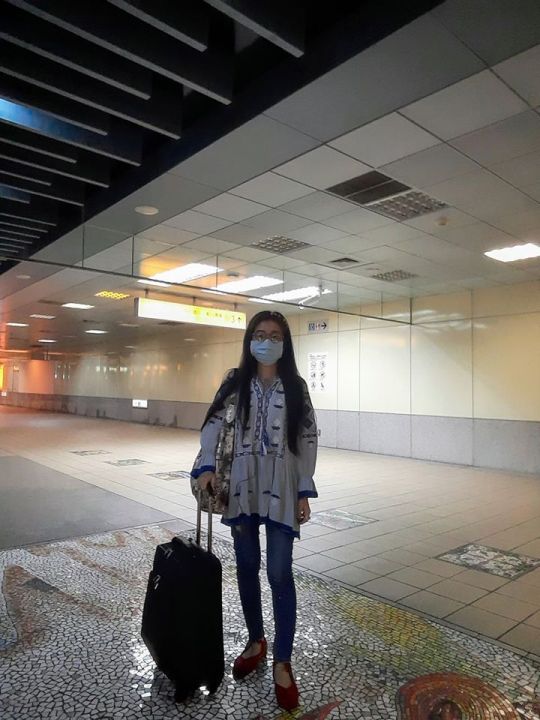


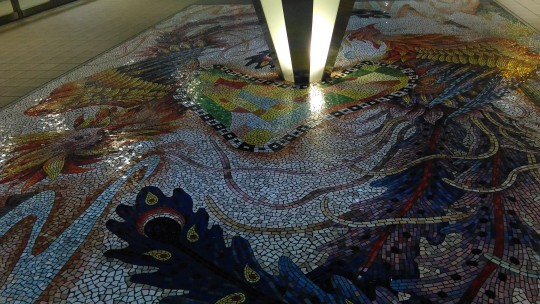

I can watch the fireworks at the top of my studio building on which festivals for silently. ( I took it few days ago there's a Tao-buddha temple played it. ) and Tonight will play fireworks from the port as years as always. In fact, fireworks allude to life just like this poem…
愛那麼短,遺忘那麼長。
love is so short, forgetting is so long.
─ Pablo Nueda’s piece “Poem 20.”
And
@thethirdman8 Friend, Wishes you have a very Very VERY
🐉 ░░H░A░P░P░Y░░N░E░W░░Y░E░A░R░2024░░🐉
Your question makes me feel ashamed. I have worked hard all my life and am over fifty years old but even don’t have a house of my own. However, I feel happy for myself because I have not kept even a cent of everything I have earned. All for the people I love. Not having a "house" means that I can fly away to watch fireworks at any time. Although I don't like to go to crowded places to join in the fun, the deeper meaning of "watching fireworks" is that I do my best to achieve the success of others. Life is as brilliant and beautiful as fireworks. I can see that their peace, joy and happiness are also equal to the peace and happiness in my heart!
I can celebrate "New Year's Eve" at any time, because I am a freelancer and I am the boss of my life; but because of this, I am always ready to work with my mind at any time, even when traveling. It is inseparable from my creation. I can't go home this week because I have a cold, and my family doesn't want me to go home. They're worried that it might infect my old mother, so my son wants me to stay in the studio to rest and sleep as much as possible. He and his aunt will take care of the family, so there is no need to worry. He hopes to go home after I recover. … .. . Strangely enough an old ballad came to mind right now :
"My Old Kentucky Home, Goodnight” written by Stephen Collins Foster, 1853.
🎼 此曲是「美國音樂之父」 史蒂芬佛斯特(Stephen Foster)的名作,表達了黑人對親人的愛的呼喚和對家鄉風物的深刻記憶。我相信特別是長期離家的遊子應當會有深刻的體會。有人說「肯塔基老家鄉」是一首令人心碎的史詩,描述著當時黑奴在肯塔基州因農業經濟轉型和部份奴隸主外移,造成黑奴過剩;奴隸主把過剩的黑奴或不願帶走的黑奴直接賣給深南諸州的大農場,或賣給掮客後沿著俄亥俄和密西西比兩大河(俄亥俄河是密西西比河的支流)運到紐奧爾良的奴隸市場。黑奴買賣曾經造成黑奴家庭永別的悲劇。「肯塔基老家鄉」的原名就叫「可憐的湯姆叔叔,晚安」 (Poor Uncle Tom, Good Night) 源自: author - 斯陀(Harriet Beecher Stowe)的小說 novel 「黑奴籲天錄」 (Uncle Toms Cabin)。
📌 PS. Always sleeping in the studio me feels like wandering, a wanderer living in a deserted time and space… by the way you have to try your best to born money. get it? XD But it's lucky I am not a slave to life, I am willing to work for the people and things I love and strive to give the people I love the best life! And you? in your 2024 New Year?
Chu Lan~*
youtube
#answered#chu lan#朱蘭皮藝#fine craft artist#leather art artist#beautiful life#the year of the dragon in chinese 2024#the year of the dragon🐉 in chinese 2024#happy new year#mosaic#馬賽克#i love mosaic
20 notes
·
View notes